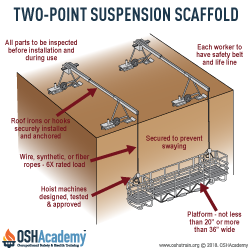Inspecting Outrigger Beams
Outrigger beams (thrustouts) are the structural members of a suspension or outrigger scaffolds that provide support. Before first use, a competent person must evaluate the outrigger beam direct connections to determine that the supporting surfaces are capable of bearing the loads that will be imposed on them. During your inspection of outrigger beams, check that:
- they are made of structural metal, or other material of equivalent strength;
- they are restrained to prevent movement;
- they have stop bolts or shackles at both ends;
- they are securely fastened together with the flanges turned out when channel iron beams are used instead of I-beams;
- they are installed with all bearing supports perpendicular to the beam center line;
- they are set and maintained with the web in a vertical position;
- they are attached to the scaffold ropes by a shackle or clevis placed directly over the stirrup;
- their inboard ends are stabilized by bolts or other direct connections to the floor or roof deck, or by counterweights;
- they are secured by tiebacks if outrigger beams are not stabilized by bolts or other direct connections to the floor or roof deck.
- they are placed at a perpendicular (horizontal 90-degree angle) to their bearing support (usually the face of the building) when feasible;
- they are placed at some an acceptable angle, with opposing-angle tiebacks if perpendicular placement is not possible because of obstructions that cannot be moved.
Knowledge Check Choose the best answer for the question.
5-8. At what angle must outrigger beams be placed relative to their bearing support?
You forgot to answer the question!

